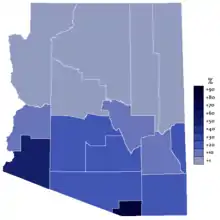Hispanics and Latinos in Arizona
Hispanic and Latino Arizonians are residents of the state of Arizona who are of Hispanic or Latino ancestry. As of the 2010 U.S. Census, Hispanics and Latinos of any race were 30.2% of the state's population.[1]
History
Arizona was thinly colonized by Mexico in the 1840s, with little protection from much larger Indian population. The U.S. won the Mexican–American War (1846–1848) and in the Treaty of Guadalupe Hidalgo (1848), Mexico ceded to the U.S. the northern 70% of modern-day Arizona.
Demographics
Hispanics made up 29.0% of Arizona's population.[2][3] The largest ancestry group in Arizona is Mexican (25.8%).[4] The southern and central parts of the state are predominantly Mexican American, especially in Santa Cruz County and Yuma County near the Mexican border.
Arizona was projected to become a minority-majority state by the year 2015 if population growth trends continued. In 2003, for the first time, there were slightly more births to Hispanics in the state than births to non-Hispanic whites. Since then, the gap has widened. In 2007, Hispanics accounted for 45% of all newborns whereas non- Hispanic whites accounted for 41% of all births. However by 2011 those trends reversed. By 2011, non-Hispanic whites accounted for 45.6% of all births while Hispanics births fell to 38.9%.[5] As of 2010, 20.80% (1,202,638) of Arizona residents age 5 and older spoke Spanish at home as a primary language.[6]
In addition, there are an estimated 45,000 people residing in Arizona who are natives of Puerto Rico or of Puerto Rican descent.[7]
Spanish language in Arizona

The state (like its southwestern neighbors) has had close linguistic and cultural ties with Mexico. The state outside the Gadsden Purchase of 1853 was part of the New Mexico Territory until 1863, when the western half was made into the Arizona Territory. The area of the former Gadsden Purchase contained a majority of Spanish-speakers until the 1940s, although the Tucson area had a higher ratio of anglophones (including Mexican Americans who were fluent in English); the continuous arrival of Mexican settlers increases the number of Spanish speakers.
References
- "Arizona QuickFacts from the US Census Bureau". Quickfacts.census.gov. 2011. Archived from the original on February 19, 2016. Retrieved January 21, 2014.
- "Arizona - Fact Sheet - American FactFinder". Archived from the original on 2020-02-11. Retrieved 2015-02-07.
- "Arizona - ACS Demographic and Housing Estimates: 2005-2007". Archived from the original on 2020-02-10. Retrieved 2015-02-07.
- "Arizona - Selected Social Characteristics in the United States: 2005-2007". Archived from the original on 2020-02-10. Retrieved 2015-02-07.
- "Births: Prelimanary Data for 2011" (PDF). National Vital Statistics Reports. U. S. Department of Health and Human Services. 61 (5). 3 October 2012.
- "Arizona". Modern Language Association. Retrieved October 15, 2013.
- https://www.azmirror.com/2019/07/25/puerto-rican-lives-matter/#:~:text=Arizona%20was%20home%20to%20more,treated%20like%20America's%20unloved%20stepchildren.